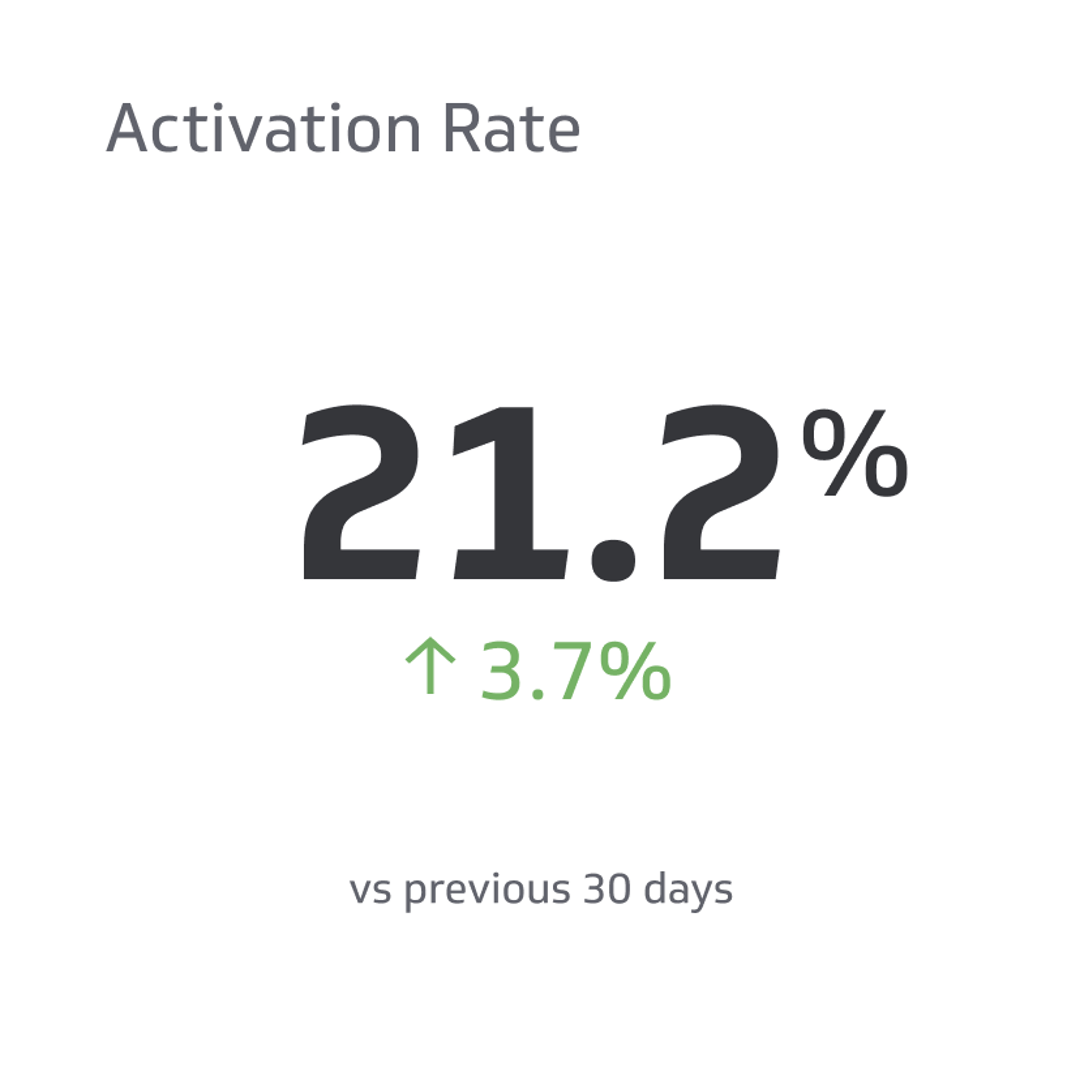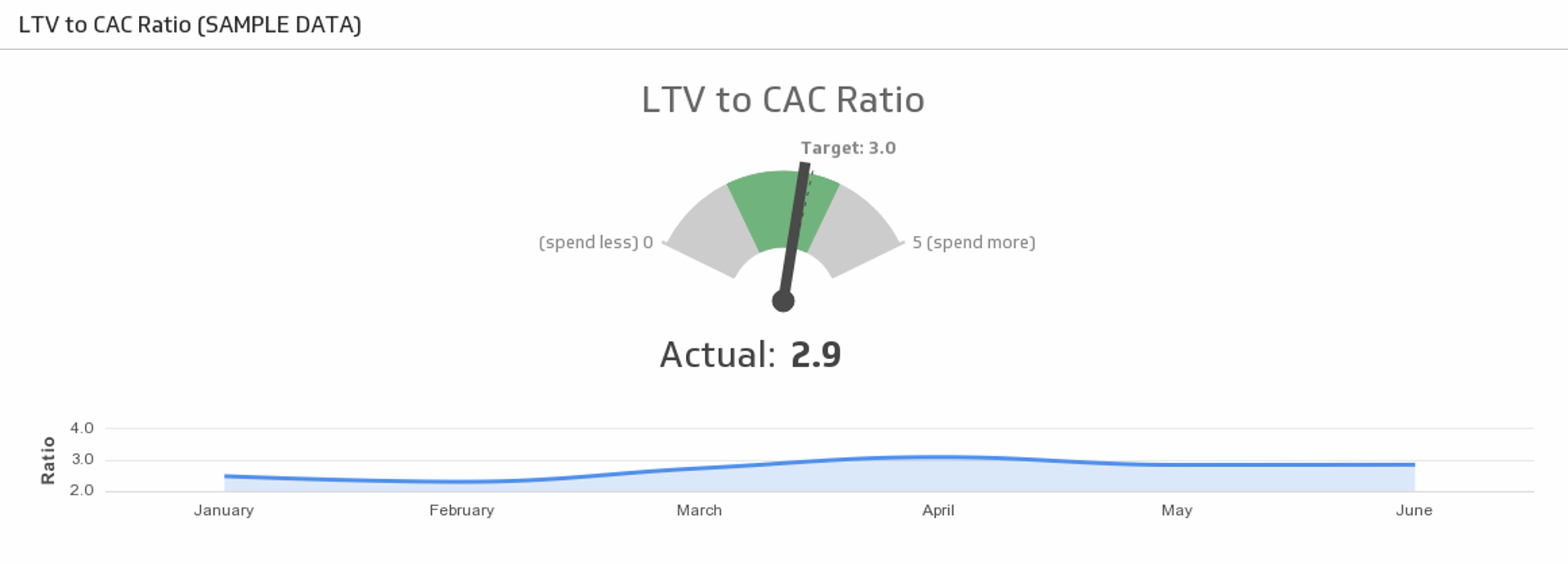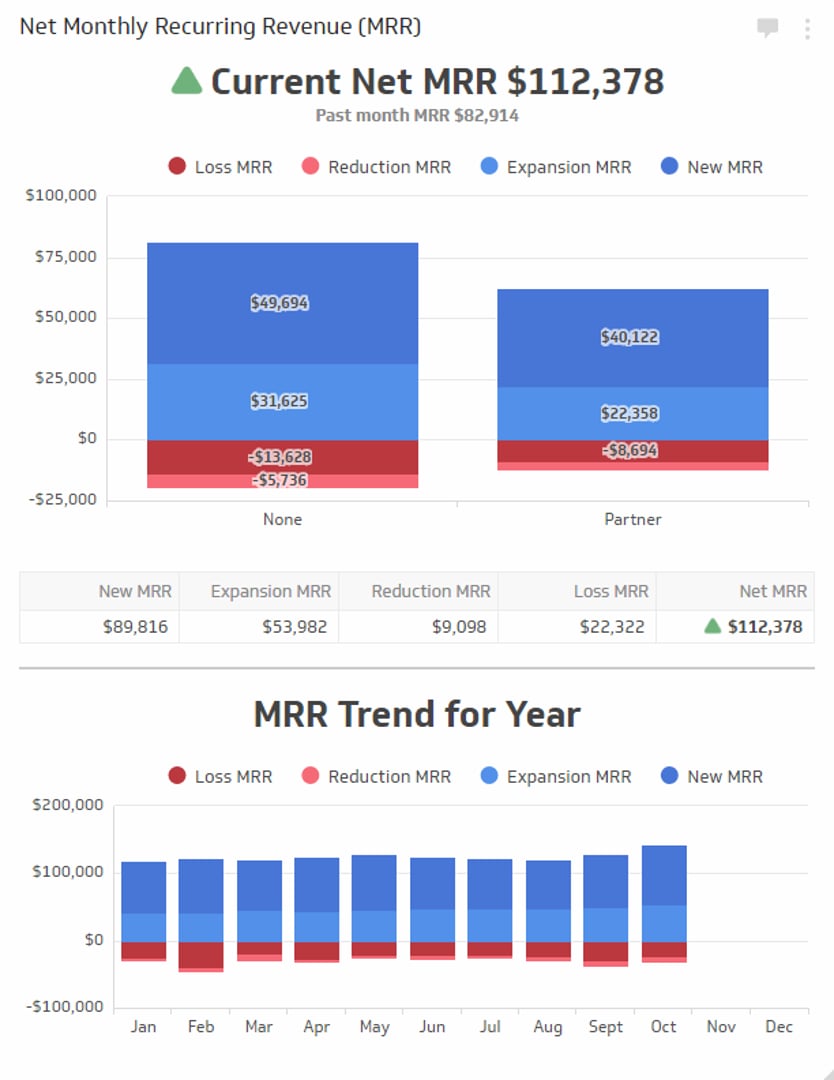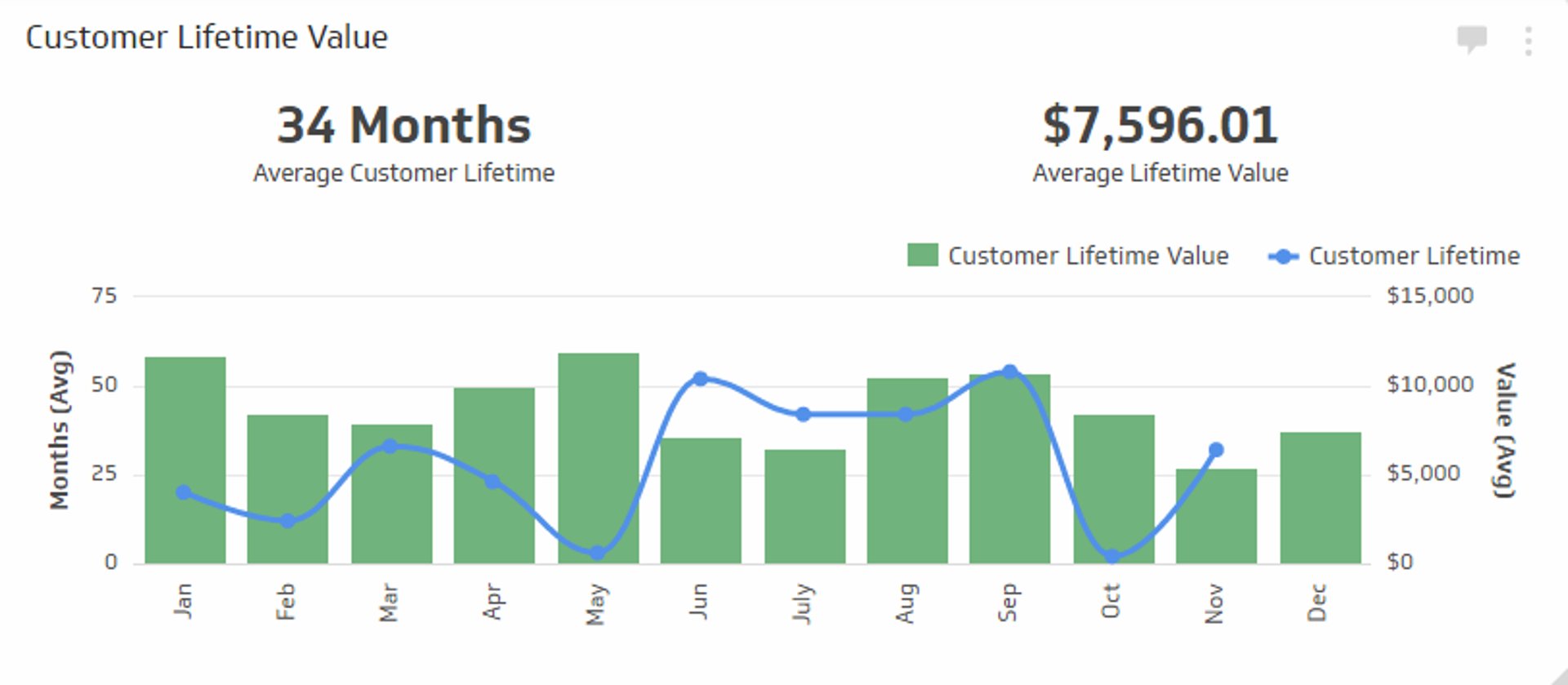Activation Rate
Activation rate measures how many visitors engage with your website or app.
Track all your SaaS KPIs in one place
Sign up for free and start making decisions for your business with confidence.

What is Activation Rate?
Activation rate measures how many visitors engage with your website or app. It depends on the desired action you want them to take, such as purchase or signup. It shows whether your product or service delivers value and satisfies your users.
Understanding Activation Rate In SaaS
In today's fast-paced business world, understanding the Activation Rate is essential for SaaS professionals and entrepreneurs. As a crucial metric for measuring user engagement, it serves as a powerful tool to gauge the effectiveness of products, features, and promotions.
Defining Activation Rate
Activation Rate is the percentage of users who take a desired action (such as making a purchase or completing registration) after engaging with a product, feature or promotion.
The Significance Of Activation Rate In Business
The activation rate holds great significance in the world of business, particularly for SaaS companies and e-commerce platforms. By measuring the percentage of users who take a desired action after engaging with a product or service, businesses can assess the effectiveness of their marketing efforts, user onboarding processes, and overall user experience.
Conversely, a low activation rate could signal potential issues such as ineffective communication or poor interface design. This metric is essential for any company looking to grow its customer base and generate revenue consistently.
Formula And Calculation Methods
Calculating the activation rate for a business involves using a specific formula and methodology, which helps determine how effectively users are engaging with a product, feature, or promotion.
Generally speaking, activation rate is calculated by dividing the number of users who take the desired action (such as signing up for a service or making a purchase) by the total number of users presented with that opportunity.
For example, let's say your SaaS company offers free trials to potential customers and has an email campaign targeting 10,000 leads. If 3,000 of those leads sign up for that trial offer after receiving your communication material, your activation rate would be 30% (3,000 / 10,000 * 100).
Real-world Examples
One prominent real-world example of a successful activation rate comes from Dropbox, the cloud storage service. Recognizing the potential impact of a seamless user experience on their activation rate, they focused on creating an intuitive and straightforward interface for users to navigate.
Another compelling example is Trello, the popular project management tool. To optimize their activation rates, Trello implemented an engaging onboarding process that introduced essential features through interactive tutorials and clear visual cues within the platform.
As a result of these efforts, new users were quickly able to grasp the product's value proposition and become actively involved in using it.
Factors Affecting Activation Rate
Several factors can affect a product's Activation Rate, including the user onboarding experience, user engagement and interface design, product features and benefits, as well as marketing communication strategies.
The User Onboarding Experience And Its Impact On Activation
The user onboarding experience is a critical factor in determining the activation rate of businesses. A smooth and engaging onboarding process can significantly improve the chances of users taking desired actions after engaging with a product or feature.
Businesses need to ensure that their onboarding process is simple, clear, and easy to follow.
For example, companies like Dropbox have successfully optimized their activation rates by simplifying their onboarding process for users. By focusing on educating customers about how to use their service rather than solely marketing it, Dropbox was able to increase its conversion rate from free trial users to paying customers by 10%.
The Role Of User Engagement And Interface Design
User engagement and interface design are critical factors that can have a significant impact on activation rate. Engaging users by providing an intuitive, user-friendly experience is key to getting them to take action.
The interface design should be visually appealing, easy to navigate, and provide clear calls-to-action.
Additionally, retention rate plays a huge role in the success of any business. User engagement can significantly impact not just activation rate but also adoption and retention rates.
By optimizing these critical touch points throughout the customer journey with best-in-class UI/UX strategies, businesses can improve their activation rates substantially while simultaneously driving revenue growth via increased sales conversions over time.
The Importance Of Product Features And Benefits
Product features and benefits play a critical role in activation rate optimization for businesses. The value of a product's features can incentivize users to take specific actions, such as signing up or making a purchase.
In addition, the perceived benefits of those features can help demonstrate the overall value proposition of a product or service.
For example, Slack's activation success is directly tied to its feature set and user experience design: easy integration with other tools, flexible communication options including direct messaging channels, and customizable notifications all contribute towards high adoption rates among business teams.
Similarly, Zoom has enjoyed significant uptake thanks to its reliable video conferencing capabilities which appeals to enterprises who require clear communication between team members geographically dispersed .
The Impact Of Marketing And Communication On Activation Rate
Marketing and communication play a vital role in activation rate, as they can attract users to engage with a product or feature. Effective marketing campaigns can increase user awareness and generate interest in the product, which can lead to higher activation rates.
For instance, Slack's successful marketing campaign highlighted its unique features and benefits through targeted ads on social media platforms. The company's clear branding strategy helped them stand out among competitors and attract more users, resulting in higher activation rates.
Similarly, Dropbox effectively communicated its value proposition through personalized email campaigns that emphasized its ease-of-use features.
Therefore, businesses should focus on developing effective marketing strategies that highlight their products' unique selling points while optimizing their communication channels to enhance user engagement levels across all stages of the conversion funnel.
Strategies For Increasing Activation Rate
In this section, we'll explore some effective strategies for improving your activation rate, including simplifying the onboarding process, implementing personalized recommendations and incentives, and improving communication and customer support - don't miss out on these actionable steps to optimize your user engagement!
Simplifying The Onboarding Process For Users
One effective strategy for boosting Activation Rates is simplifying the onboarding process. Providing a streamlined, hassle-free experience for new users can increase adoption and engagement rates.
This means creating an easy-to-understand interface that guides the user through their first interaction with your product or service.
For example, Dropbox used this approach when they added a step-by-step tutorial to their initial sign-up process. The tutorial allowed new users to understand how to use the tool effectively and tackle any potential roadblocks early on in their usage journey.
Implementing Personalized Recommendations And Incentives
Implementing personalized recommendations and incentives is one powerful strategy that businesses can use to increase their activation rates. By understanding the unique needs, preferences, and behaviors of users, companies can offer tailored recommendations and incentives to encourage them to take action.
For example, a SaaS company may provide personalized guidance on how users can optimize their experience with the product based on their usage patterns or goals.
Research has shown that personalized recommendations and incentives have a significant impact on user engagement and retention. In fact, 80% of customers are more likely to do business with a company if it offers personalized experiences.
Improving Communication And Customer Support
Improving communication and customer support can have a significant impact on activation rate for businesses. Providing clear, concise communication with customers during the onboarding process can help reduce confusion and frustration, leading to higher activation rates.
One great example of a business that has excelled in this area is Slack. By providing quick responses through multiple channels such as email or Twitter DMs, Slack has earned a reputation for excellent customer support.
This commitment to customer satisfaction has resulted in impressive adoption rates for the platform - with over 10 million daily active users worldwide.
Tools For Measuring Activation Rate
To ensure that businesses are accurately measuring user engagement and improving activation rates, there are various tools available, including A/B testing for optimization, analytics tools to track progress, as well as gathering customer feedback; read on to discover how these can be implemented.
The Importance Of A/B Testing For Activation Rate Optimization
A/B testing is a powerful tool for optimizing activation rates in SaaS products. Essentially, it involves testing two different versions of a product or feature to see which performs better with users.
For example, Dropbox famously used A/B testing to improve their activation rate by over 10%. They tested various email subject lines and copy to see what resonated best with users, ultimately settling on concise messaging that emphasized the ease of use and value proposition of their product.
This simple change resulted in higher engagement and stronger conversion rates for new users.
Analytics Tools To Track Activation Rate
There are various analytics tools available that businesses can use to track their Activation Rates. These include tools like Google Analytics, Mixpanel, and Amplitude. By using these tools, companies can gain valuable insights into the user journey and understand how users interact with their product or service.
For example, Google Analytics provides businesses with a clear overview of their website's performance by tracking metrics such as bounce rate, time on page, and conversion rate.
Mixpanel offers advanced behavioral analytics that allow businesses to track specific user actions and behaviors within their app or platform.
By using these analytics tools to measure Activation Rate effectively, businesses can generate more revenue from higher user engagement levels while benefiting from increased customer loyalty over time.
Gathering Customer Feedback To Improve Activation Rate
Gathering customer feedback is a crucial step in improving Activation Rate. It provides valuable insight into the user experience and reveals areas of improvement that businesses may not have considered before.
Analyzing this data can help companies identify patterns and trends in customer behavior, enabling them to make informed decisions about optimizing their activation processes.
For example, if users consistently struggle at a certain point during onboarding, it might indicate that the instruction needs to be clearer or more accessible.
Examples Of Successful High-Activation Businesses
In this section, we will analyze how Slack, Dropbox, Trello and Zoom have optimized their activation rates and explore the key strategies they implemented to improve user engagement.
Analysis Of Slack's Activation Rate Success
Slack, the popular workplace messaging app, has achieved impressive activation rate success. With an activation rate of 93%, Slack boasts one of the highest rates in the industry.
Their success can be attributed to their user-centric approach from design to onboarding.
Additionally, Slack's use of incentives such as free trials and rewards for referrals have also contributed to their high activation rate.
How Dropbox Optimized Their Activation Rate
Dropbox is a cloud storage company that has achieved significant success with its product. Their activation rate optimization strategy involved simplifying the user onboarding process.
They identified an issue where users were getting overwhelmed with features and options, leading to confusion and disinterest. To solve this problem, Dropbox implemented a step-by-step tutorial that helped new users get started easily.
This change led to a 10% increase in activation rates within the first month of implementation.
By simplifying the onboarding process for users, businesses can reduce confusion and make it easier for customers to engage with their products or services at a much faster pace than before.
Trello's Activation Rate Optimization Strategies
Trello is a great example of how businesses can optimize their activation rate using effective strategies. The first step they took was to simplify the onboarding process for users, which helped them improve their retention rate significantly.
Trello also implemented personalized recommendations and incentives to encourage user engagement with the platform.
Trello made customer support a top priority by providing excellent communication channels, including email, live chat support, and an extensive knowledge base that answered common questions.
Additionally, they used analytics tools like Google Analytics and Mixpanel to track their activation rate success rates continually.
The Success Of Zoom's Activation Rate
Zoom is a prime example of a company with an excellent activation rate. The video conferencing and communication platform has consistently experienced staggering growth since its founding, in part due to its high activation rate.
Zoom's user-friendly interface design and intuitive onboarding process are key factors that contribute to their impressive activation rate performance. Additionally, Zoom continuously optimizes user engagement by seeking customer feedback and facilitating active communication through their platform.
By implementing these effective strategies, the company boasts an impressive 36% activation rate for SaaS products - significantly higher than the average or median rates mentioned earlier.
Conclusion
In conclusion, Activation Rate is a critical SaaS metric for any business looking to measure user engagement and the effectiveness of their product or promotion. By understanding the factors affecting activation rate, companies can take actionable steps towards improving it.
The onboarding process, user engagement, communication, and personalized recommendations are some key areas to focus on. Additionally, A/B testing and analytics tools can help optimize funnel conversion rates.
Looking at successful businesses such as Slack and Dropbox provides valuable insights for businesses hoping to improve their own activation rates.



